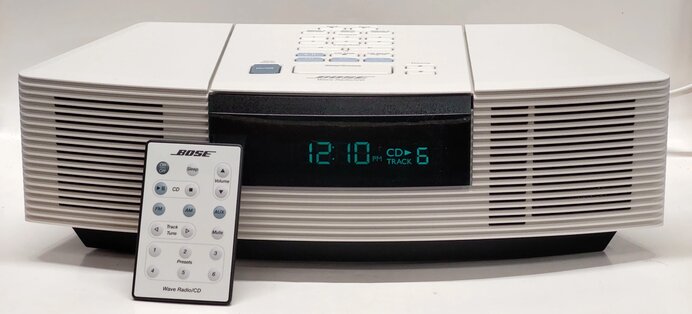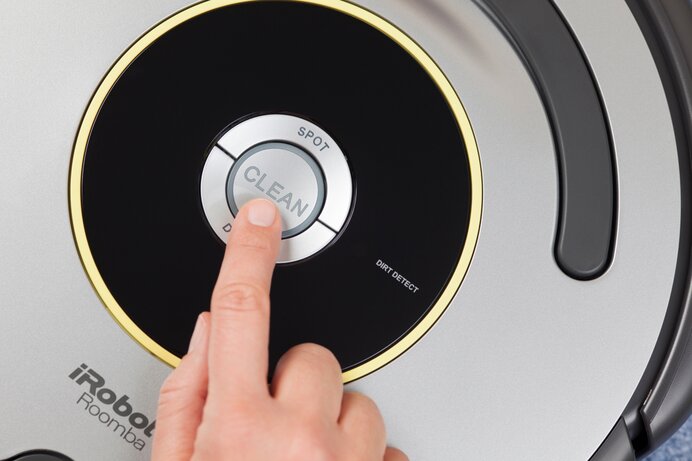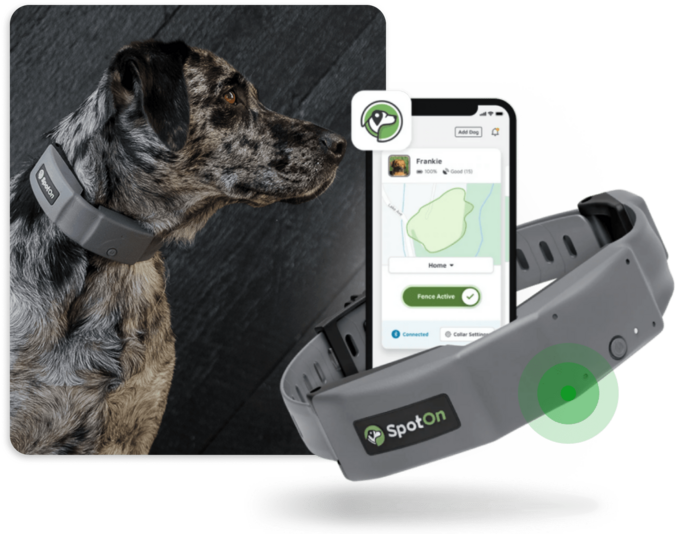Behind the Product: SpotOn’s Ken Bazydola on Pioneering IoT Solutions
Ken Bazydola, Head of Product at SpotOn, shares insights from his career as an IoT product leader, including lessons learned from his time at Bose and Roomba, how SpotOn fosters product success, and why user insights drive great IoT experiences.

Imagine starting your career as an engineering co-op student working as a calibration technician, then working as a factory automation engineer on products like caskets, to videotape, and semiconductors, then finally pivoting to product management and helping create some of the most successful IoT products of the last 20 years. That's been the journey for Ken Bazydola, Head of Product at SpotOn, who's witnessed IoT’s evolution firsthand at giants like Bose and Roomba. Now, he's pushing the boundaries of GPS fence technology and pet wellness with SpotOn's innovative solutions.
At Whitespectre, we are proud partners in this journey, having developed SpotOn's React Native app and powerful backend since 2020. Mateo Arizcorreta, Product Manager at Whitespectre for the SpotOn team, sat down with Ken to hear about his story and career-defining moments from the tech trenches.
- Navigating career transitions from Engineering to Product Management
- Bose's Innovation Culture and the hard lessons from maintaining secrecy in product development
- Strategic decision-making in IoT product management with a Software-First approach
- Scaling premium features in Roomba for global accessibility and cost-balance
- Integrating Product Discovery and Marketing in the Roomba success story
- Embracing risks and owning mistakes when developing with a small team
- Envisioning the future of SpotOn and trends in IoT innovation
When you look back on your career, what are some of the IoT challenges that seemed impossible some years ago but eventually became possible?
Twenty years ago, many of the technologies we now take for granted either did not exist, had limited performance, or were simply too costly for a consumer electronics product. Things like Bluetooth, cellular technology, processors, and batteries were relatively immature. Smartphones did not exist.
It was typical at Bose to pitch ideas well ahead of their time, which would often resurface later in a different form. For instance, I pitched a concept for a portable wave product. We envisioned audio products moving outdoors, disconnected from wall power, so this prototype had a built-in hard drive and battery power. This product never moved forward, which, as it turns out, was a good thing.
The iPhone and music streaming services were coming and this product would have not been successful. But this project eventually influenced the creation of the SoundDock, Bose's first audio speaker for the iPod. And then SoundDock portable. Both of these products were wildly successful.
Before working at Bose or SpotOn in Product, you started as a mechanical engineer. How did you pivot from a mechanical engineer to a Product Manager?
For many years, I worked in companies close to the manufacturing side and in some areas that no longer exist, like floppy disks, cassettes, and videotape. Eventually, I found jobs in the semiconductor industry, in positions closer to design engineering on automating stuff. While working at PRI, where we worked on full factory automation for semiconductor factories, people called “product managers” would guide product roadmaps and what we should build, which caught my interest. Back then, they needed people with technical knowledge to do product management, so I took the opportunity and loved it. I did that for a few years, and then I started looking for my next job in product and landed at Bose in 2001.
What were your initial projects at Bose?
I worked with the team that created the Wave radio. At that time, we had the Wave radio with just AM/FM and CD. We were also working on launching a product called Wave/PC in 2001. This product had an app that would run on your desktop, enabling you to rip your CDs into your computer and play them using a computer interface and remote control. This was before iTunes was even a thing. And the iTunes desktop app ended up looking a lot like the Wave/PC app. The product was NOT a big hit - people wanted to listen to their music from the Wave system, but away from their PCs. In many ways this product was ahead of its time, but in other ways technologies, like wireless, did not yet exist.
I worked on many early product concepts at Bose, most of which were eventually killed off and never made it to market. Although I'm proud of all our work, sometimes it's hard to explain to outsiders that we had to kill off so many concepts. They would ask, "You killed how many concepts?" Then, out of the 45 concepts, we launched only five, and that's how it works.

How did that pitching process at Bose work?
The process involved writing a product vision document that included an internal ad that followed a specific construct. The ad showcased a person enjoying an experience but facing a problem and then presented the Bose technology as the solution. A business plan and a pre-development plan were put together to assess the product's viability, and a certain amount of money was allocated for pre-development to mitigate risks. The ideas were put in a portfolio, and the leadership team would pick the best ones.
What were your main takeaways during your Bose days?
Bose was an excellent learning experience for me. It taught me to focus on the needs and problems of users, the importance of having a good understanding of technology to solve those problems, and how to motivate the team to work through daily user issues. In short, I gained the ability to develop a sense of product prioritization, knowing what's essential and what's not.
However, I also learned a valuable lesson about the dangers of being too secretive during product development. Although we focused on our users and consumers, we were also highly confidential. We kept everything close to the chest so we wouldn't show anything to external consumers or share product concepts. Unfortunately, we were so worried about someone copying us that we wouldn't get valuable consumer feedback. As a result, we sometimes failed to create the right product. The most important lesson I learned was how crucial it is to seek insights from users and consumers while developing a project.
Do those insights apply differently to an IoT product than to pure-play software?
Well, when developing software in IoT products you need to work smarter because it involves embedded hardware systems with finite resources. In contrast, pure-play software as a service typically has more resources in the cloud and thus you have a wider set of solutions. Another key aspect is that with hardware products, you have the physical product in an environment with a user, whether outdoors or a robot. These factors profoundly affect how software and user experience are built. Because of these two reasons, you’ll always want to try to solve whatever problem the user might be going through with a software solution first at the app level and leave solutions that involve changes in the firmware of the physical product only as a last resort.
How can you ensure an IoT product is user-friendly, considering the unpredictable ways users might interact with them?
It's important to reduce complexity by making choices for them on a UX level. This will result in a simpler product that's easy to use. However, it's not always easy to strike a balance because some consumers enjoy having options like buttons and knobs to customize their devices. For instance, iOS and Android are two platforms that serve different types of users. Apple makes everything super easy and seamless, while Android is more configurable. Based on my experience, I believe in keeping things straightforward, like plugging in a radio that just works. So, reducing complexity is always a top priority.
How was the transition from Bose to IRobot?
After 12 years at Bose, I joined iRobot as Director of Product. It was a fantastic experience as iRobot was a more flexible company, which was a big adjustment for me. It gave me more freedom to move faster, and that was cool. At the time, Roomba was still a robot that would bounce around and wander. It was smart because it wasn't completely random, but it wasn't learning anything. It was just reacting. When I joined, the company was already working on robots that could navigate, build a map using a camera, and learn from it. I worked on all that stuff, like the next-generation Roombas that could map the house, find their way back to the home base, build a map automatically, empty the dust bin, and do all this through connectivity.

What were your main goals back then at Roomba?
We aimed to incorporate more advanced technology, enhance its capabilities, and increase its price. We were successful in doing so, which allowed us to gradually introduce the new technology into lower-end models as we developed even more advanced features for premium models. Our focus was on improving the cleaning performance, and we put a lot of effort into understanding the mechanics of vacuuming systems and how we could improve ours.
What strategies did you apply for balancing pricing and introducing new technology?
You learn how to play with scale when working at a company like iRobot. WiFi is an excellent example of that. Initially, we put WiFi only in our premium systems because WiFi modules were expensive, and we couldn't figure out how to make them more affordable. But as we scaled up production from 100,000 robots to a million robots, we found that the costs came down. Additionally, we could remove some redundant user interfaces on the robot and rely on the app instead. These changes helped us save money and make WiFi more accessible.
Roomba's ad campaigns were always very smart; how were the marketing strategies intertwined with product development?
We put much effort into understanding the real problem we were trying to solve. Roomba may be less powerful than regular vacuum cleaners, but they offer the advantage of self-operating, enabling you to clean more frequently and quickly. This results in a cleaner house without manual labor or remembering which areas have already been cleaned. A good counter-example is how Dyson simply put their stick vacuum on a robot, resulting in a robot that was too tall and with too much suction, which caused the robot to get stuck and stick to the floor. This shows that it's not necessary for a product to work “like something else” to succeed.
User insights were also super helpful in shaping the messaging. We soon discovered that many people cleaned their homes manually while the Roomba is running. Realizing this, we modified our messaging to emphasize the Roomba as a “helping hand” rather than a replacement for the user. We conducted statistical analysis to identify the most effective messages from our focus groups and launched our marketing campaign, which significantly boosted our business growth.
After spending 6 years at Roomba, you moved to SpotOn, now the number one GPS dog fence. What was the main motivation behind your move to SpotOn?
I was excited about SpotOn's mission to provide an innovative solution for pet owners who spend thousands of dollars on wired fences. The product uses high-level GPS, cellular, and Bluetooth-powered collars to ensure pet safety. I was impressed that their product was already on the market and functioning. They needed help improving their Gen 2 and had a team that was highly skilled and motivated to achieve their goals.

What was the first thing you worked on when you joined SpotOn?
Product vision and product requirements. There was one for Gen 1 of the SpotOn collar but none for Gen 2. So by crafting and aligning on a product definition, we ensured that the whole team was working on the right product. So get a definition down, align on that, but then work through all the details.
And how did you navigate the pressure of making a top-notch product with a smaller department than in your previous companies?
It's a good adrenaline rush. When you're a small startup, you've got to take chances, and you have to use judgment and just go and fix it afterward. This is an interesting progression for me because I went from working at Bose where making a mistake was not an option, to iRobot where we didn't want to make mistakes, but we didn't have systems to prevent them. At SpotOn we allow ourselves to learn all the time. When there’s a problem, we focus on fixing it and the lessons we gain, not figuring out whose fault it is. By working closely with some of the most brilliant people I’ve ever worked with, we launched Gen 2, which is drastically better than the first generation and has been sold and received extensively.
What would you like SpotOn to evolve into from a product perspective?
There are many opportunities to improve the experience for dog owners and dogs and craft affordable and durable products that were once deemed impossible. I want to keep pushing that barrier of what's possible and benefit our users along the way.
Are you optimistic about how IoT products will develop in the future?
There’s a big limitation in IoT which is that everyone wants to connect everything (your refrigerator to your washing machine), but companies do not want to share data, leading to a lack of cooperation on standards. Everybody wants to own the ecosystem. The other thing is that IoT is full of products that are a bit silly, they are not serving a real user. So I think that the next big thing in IoT is whatever keeps solving real problems. We used to say a Bose. "I need to make this product as simple to use as that light switch on the wall”. And unless it's better than that, I’m not betting on anything.
